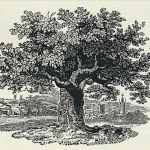In my research I have often come across references to Johnson’s Tavern as a landmark. Deeds refer to it when identifying roads, like “the road from Swamp Meeting House (Locktown) to Johnson’s Tavern” or “the road from Rittenhouse Tavern (Rosemont) to Johnson’s Tavern.” And sometimes it is just “the great road to Johnson’s Tavern,” which is today’s Route 519 through Kingwood Township.
Barber
Barber Burying Ground

The Barber Cemetery, located on Lambertville-Headquarters Road in Delaware Township, Hunterdon County, NJ, is one of the oldest cemeteries in the county. It is located on a two-acre plot and contains upwards of 516 burials, beginning as early as the 1740s.
Bucking the Party Line in 1812
Two Letters Written by Sen. John Lambert
Senator John Lambert of Amwell is one of Hunterdon’s most interesting historical figures.1 He served in the state legislature during the Revolution and afterwards served as Acting Governor before being elected to Congress and then to the U.S. Senate.
Barber Family Tree
 First Generation:
First Generation:
(1) Samuel Barber (c.1690 – 1751) & Eliada Alida Johnson (c.1695 – after 1782)
The Barber Family in present day Hunterdon begins with Samuel Barber who died sometime before May 1751, age about 61. It is not clear who his parents were. The family was primarily located on Lambertville-Headquarters Road in Delaware Township. Much of the family information comes from Hiram Deats’ notebook on the Barber Family at the Hunterdon Co. Historical Society, which includes his transcription of the Barber family bible.
Cornelius H. Barber
Sometimes in my researches on Hunterdon people of the past, odd things turn up. Something very odd turned up when I came across Cornelius H. Barber, who lived from 1804 to 1884. I had been asked about the Prall tanyard, which was located a short distance south of Sergeantsville in the early 1800s, and discovered that Barber had briefly been an owner.
So let me tell you a little about Cornelius Hoppock Barber before describing the odd thing I found.
The Gershom Lambert Farm
Because there has been some confusion about exactly where Sen. John Lambert lived, I have spent the past two articles determining that his farm was located on Seabrook Road and not on Lambertville-Headquarters Road, as some have thought. The confusion was caused by the fact that both farms were owned at one time by men named John Lambert and Gershom Lambert.
Sen. Lambert’s Farm, pt 2
A continuation of the article on Sen. John Lambert’s home farm.
Having discovered which of two farms belonged to Sen. John Lambert, I realized how amazingly interconnected the Lambert family was. That will hold true even more so here in part two. However, I have not done all the research that could have been done before publishing this article. It was a question of when to stop.
Two Lambert Farms
There are two farms in southern Delaware Township that are particularly interesting. They were part of the old Dimsdale proprietary tract north of Lambertville until 1750, when John Lambert, a recent immigrant from Connecticut, purchased it.
Bowne Station
This article by Egbert T. Bush answers some questions about the Bowne farm that were raised in the previous post, “Dr. Bowne’s Homestead.“1 Lora Olsen had pointed out that there were two houses on the property, one quite old, and one built in the mid 19th century. But it turns out there was a third house—one built for the slaves that lived on the farm.
The Daybooks of Dr. Bowne
Recently I attended a workshop given by archivist Don Cornelius on the holdings of the Hunterdon County Historical Society. They are extensive, far more than I realized. Among them are the original daybooks of Dr. John Bowne of old Amwell Township, filled with the names of his patients and their treatment. These Daybooks are so important to genealogists that someone at the Historical Society has gone to the considerable effort of indexing the names into a card catalog, and—primitive as it may seem to be today—it’s a very useful genealogical tool for the time period of 1791 through 1857.